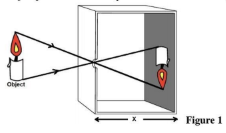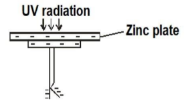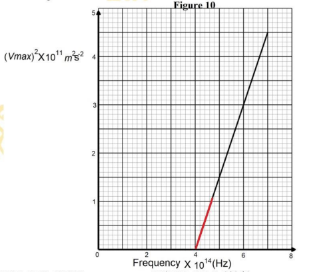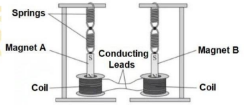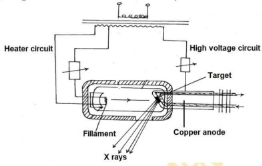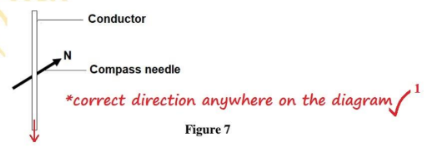Instructions to candidates
- This paper consist of TWO sections;A and B. Answer ALL the questions in section A and B .
- ALL working must be clearly shown. Mathematical tables, electronic calculators and slide rules may be used.
- Take h = 6.63 × 10−34 Js, e = 1.6 ×10−19C, mass of electron = 9.11 × 10−31kg
Section A (25 marks)
Attempt all questions in this section in the spaces provided
- Figure 1 shows an object placed in front of a pin-hole camera whose length X is adjustable.
One of the effects of increasing length X is formation of an enlarged image. State the other effect giving a reason for your answer. (2 marks) - Figure 2 shows the printing system of an inkjet printer
Identify the type of charge on the charged ink drops. (1 mark) - Give two benefits of high voltage transmission of electrical power. (2 marks)
- Figure 3 shows an aluminum ring placed between the poles of magnets.

Figure 3
Sketch the magnetic field pattern between the poles of the magnets. (1 mark) - Figure 4 below (drawn to scale) shows the image I, formed by a convex mirror. F is the virtual

Figure 4
Using ray diagrams locate the position of the object and draw the object (2 marks) - An electric bulb is labeled 100W, 240V. Determine the current through the filament (2 marks)
- State and explain how an increase in humidity affects the speed of sound in air. (2 marks)
- One of the defects of simple primary cells is polarization. Explain how this defect prevents current flow in a cell. (2 marks)
- Figure 5 shows a ray of light incident on a right-angled glass prism.
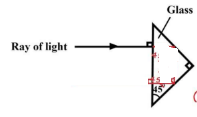
Figure 5
Given that the refractive index of glass is 1.5, draw in the figure above the path followed by the ray of light until it emerges from the prism.
(2 marks) - Figure 6 (drawn to scale) shows wave fronts approaching an obstacle with an aperture.
Figure 6
Draw the wave fronts as they appear after passing through the aperture. (1 mark) - A compass needle is placed below a current carrying conductor as shown in figure 7.
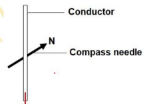
Indicate on the diagram the direction of the current. (1 mark) - The target of modern X-ray tubes are made to rotate. Explain
- State two reasons why gamma rays from a radioactive source are preferred to X-rays from an X- rays tube in sterilization of medical equipment.
- The following reactions are part of a radioactive series.
Identify the radiation X - Current is made to flow through a resistance wire for some time. Explain why temperature of the wire rises (2 marks)
Section B (55 marks)
Attempt all question in this section in the spaces provided.
-
- Distinguish between a real and a virtual image (1 mark)
- Figure 8 shows scale drawing of a window frame and its image produced on a screen by a convex lens.
- State the nature of the mage formed (1 mark)
- Determine the linear magnification of the image (2 marks)
- The image of the frame was produced 500 mm from the lens.
Determine:- The distance of the actual frame from the lens (2 marks)
- The focal length of the lens (3 marks)
- A student finds that at a distance of 25cm, the words in a book look blurred.
- State the eye defect the student is suffering from (1 mark)
- Name the type of lens that can be used to correct the above defect. (1 mark)
-
- Figure 9 shows ultra-violet light striking a polished zinc plate on a negatively charged gold leaf electroscope.
Figure 9
Explain the following observations.- The leaf of the electroscope falls. (2 marks)
- When the same experiment was repeated with a positively charged electroscope the leaf did not fall. (2 marks)
- State two factors which determine the speed of photoelectrons emitted from a metal surface. (2 marks)
- Figure 10 shows a graph of the square of the maximum velocity (Vmax)2 of the emitted photoelectrons against the frequency (f) of the radiation causing photo-electricity on a clean zinc plate
- Determine the slope of the graph. (2 marks)
- Given that the equation of the line is (Vmax)2 = 2h f − 2h fo, where me = 9.11x10−31 kg.
me me
From the graph determine the:- Minimum frequency of the radiation that will cause emission of electrons from the zinc surface. (1 mark)
- Planck's constant. (2 marks)
- Minimum amount of energy required to just emit electrons from the zinc surface. (2 marks)
- Figure 9 shows ultra-violet light striking a polished zinc plate on a negatively charged gold leaf electroscope.
-
- Figure 11 shows two magnets A and B suspended by springs in two separate coils connected as shown.
Figure 11- Magnet A is set to oscillate in the coil. State the observation made on magnet B. (1 mark)
- Explain the observation in (i) above. (3 marks)
- State Faraday's law of electromagnetic induction. (1 mark)
- Figure 12 shows two coils wound on a laminated soft iron core. It is connected to a 300V mains supply.
Figure 12- Identify the type of the transformer in figure 12. (1 mark)
- The transformer in figure 12 loses 20% of the input energy into heat per second. Determine the maximum current measured on the ammeter, if the input current is 2A. (3 marks)
- Explain how energy losses in the transformer in figure 12 are minimized by having a soft iron core. (2 marks)
- Figure 11 shows two magnets A and B suspended by springs in two separate coils connected as shown.
-
- A p-type semiconductor is made by doping a pure silicon crystal with few boron impurity atoms. Describe how this p-type is formed.
(2 marks) - Figure 13 shows an incomplete diagram of a centre tap full-wave rectifier.
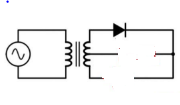
Figure 13- Complete the diagram by placing the missing components using their circuit symbols (2 marks)
- Figure 14 shows how the input voltage of the full wave rectifier in figure 13 varies with time.
Figure 14
Sketch, in the axes provided, a graph showing the output voltage of the rectifier in gure 13 varies with time. (1 mark)
- Figure 15 shows a circuit having the following components: a 20V p.d source, a voltmeter, three switches S1, S2 and S3 and two capacitors C1 and C2 of capacitance 13μF and 8uF respectively.
Figure 15 - Determine the charge on C1 when switches S2 and S3 are closed while S1 is open. (3 marks)
- After some time S3 is opened and both S1 and S2 are closed. Find the maximum voltage, V recorded by the voltmeter (3 marks)
- A p-type semiconductor is made by doping a pure silicon crystal with few boron impurity atoms. Describe how this p-type is formed.
-
- A.G.M tube may register some effect in the absence of a radioactive source. Explain this observation and state one cause. (2 marks)
Explanation:
Cause: - A radioactive element A of half-life 31 days decays to element B. A sample of A of mass 32g is kept in a container. Assuming B is stable, calculate the mass of B that will be in the container after 124 days. (3 marks)
- Figure 16 shows the features of an x-ray tube.
Figure 16- Give a reason why thick copper block is used at the anode. (1 mark)
- State how the energy of the X-rays can be increased. (1 mark)
- X-ray tube operates at 100kV between the cathode and the anode. Calculate the maximum energy of the X-ray photons produced.
(charge of an electron,e=1.6×10−19C). (2 marks)
- A.G.M tube may register some effect in the absence of a radioactive source. Explain this observation and state one cause. (2 marks)
MARKING SCHEME
Section A (25 marks)
-
- Image becomes dimmer/less bright...
- Since light spreads over a larger area..
- Negative
-
- Power loss due since resistance of the cables is minimal...
- They are less costly (2 marks)
-
correct pattern and direction of magnetic field -

- 100 = 240 X I ✓1
I = 0.4167A✓1 -
- Speed of sound increases. ✓1
- since air becomess less dense
- Polarization terminates cell reaction✓1 due to accumulation of hydrogen gas around the positive electrode✓1
-
-
- no change in wavelength ✓1
- straight waves with slight, bends at the tip ✓1
-
- Rotation changes the point of impact. ✓1 hence reducing wear and tear/enables longer scans to be done, and at higher doses/allows heat to be spread over a larger area...✓1
-
- Sources of gamma rays are more portable... ✓1
- No power requirement during production of gamma rays, ✓1
- Alpha particle.... ✓1
- As electrons flow through the wire, they collide with ions/atoms/.... impurities, in the wire which cause the ions to vibrate ✓1Electrons.... therefore lose their kinetic energy in form of heat, hence increase in / temperature. ✓1
-
- A real image is that which forms on the screen by intersection of real rays WHILE virtual image is that which cannot be formed on a screen due to intersection of apparent/virtual rays.. ✓1
-
- Real
- m = v/u
= 200 ✓1
600
= 1/3 ✓1
-
- 1/3 = 500/u ✓1 ⇒ u = 3 × 500 = 1500mm ✓1
- 1/f = 1/u + 1/v =
1/f = 1/1500 + 1/500
f = 1500 × 500
1500 + 500
=375mm
-
- Long sightedness // hypermetropia ✓1
- Converging/convex lens ✓1
-
-
- U.V.. radiation dislodges electrons from the zinc plate ✓1 making it positive. The zinc plate thus attracts electrons from the leaf, hence neutralising the electroscope. ✓1
- UV radiation dislodges electrons from the zinc plate ✓1 but are immediately attracted by the positive charges on the electroscope. ✓1
-
- Workfunction of the metal, ✓1
- Energy/frequency/wavelength of the radiation. ✓1
-
- slope = (5 − 0.7)X1011 ✓1
(7.5 − 4.5)x1014
= 1.433X10−3m2s−1 -
- 4.0X1014Hz ✓1 (graph must be extrapolated)....
- 1.433X10−3 = 2h ✓1
9.11X10−31
= 6.527X10−35 Js ✓1 - E = hf
= 6.527 X 10−34 X 4.0X1014 ✓1
= 2.611X10-19 J ✓1
- slope = (5 − 0.7)X1011 ✓1
-
-
-
- The magnet oscillates vertically at the frequency of A ✓1
- Oscillating A produces a changing magnetic flux in the coil thus an ✓1 a.c current is induced, causing an alternating magnetic effect on B ✓1 making it to oscillate. Induced current opposes the change producing it. reducing both the frequency of A and the magnitude of the induced current hence magnetic effect on B reduces at the frequency of A. ✓ (I mark)
- The magnitude of the induced electromotive force is directly proportional to the rate of change of the magnetic flux linkage. ✓1
-
- Step-down transformer
- lsNs = lpNp. ✓1
Is x 600 = (2x1000) 0.8 ✓1
ls = 2667A ✓1 - The laminations are thin, thereby enhancing/increasing the resistance in each lamination. ✓1 This reduces the eddy current in each lamination, and hence the net. eddy current is reduced. ✓1
-
-
- All three electrons in the outermost energy level of Boron bond with the neighbouring Silicon atoms leaving Silicon with an extra unbonded electron. ✓1 The missing electron on Boron creates a vacancy/hole as th majority charge carrier responsible for conduction. ✓1
-
−
-
-
- Q = CV ✓1
Q = 13 X 10−6 X 20 ✓1
= 2.6 X10−4 C. ✓1 - Q = CV ✓1
2.6X10−4 = (8+13) x 10−6 × V ✓1
V = 12.38v ✓1
- Q = CV ✓1
-
- Explanation: to background radiation. ✓1
Cause: Radioactive substances in air, cosmic rays, sun's radiation, natural and artificial radioisotopes (any). ✓1 - N =. N0(0.5)n ✓1
N = 32(0.5)124/31 ✓1
N = 29✓ -
-
- Copper is a good conductor of heat therefore easily dissipates heat away
OR - Thick copper block is to provide a large surface area through which more heat is dissipated away
- Copper is a good conductor of heat therefore easily dissipates heat away
- By increasing the accelerating/anode potential. ✓1
- Energy = e V
= 1.6X10-19 X 100,000 ✓1
= 1.6X10-14J ✓1
-
- Explanation: to background radiation. ✓1
Download Physics Paper 2 Questions and Answers - Maranda High School Mock Exams 2023.
Tap Here to Download for 50/-
Get on WhatsApp for 50/-
Why download?
- ✔ To read offline at any time.
- ✔ To Print at your convenience
- ✔ Share Easily with Friends / Students

